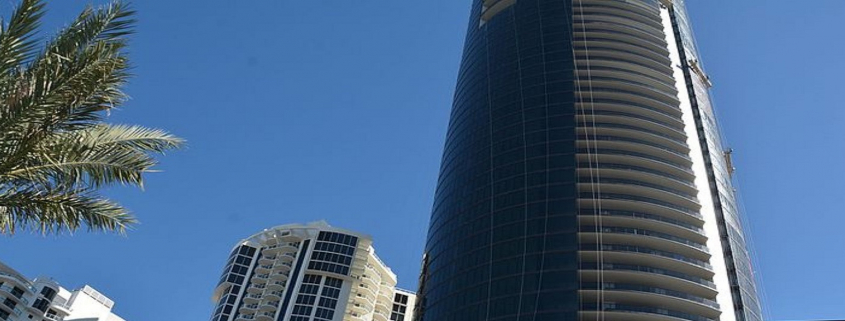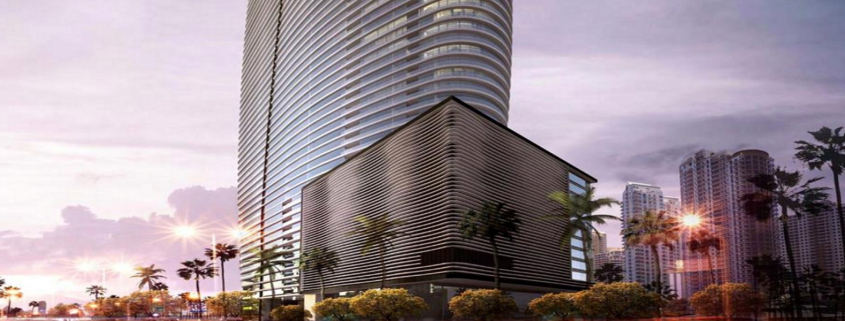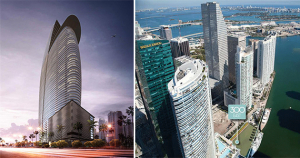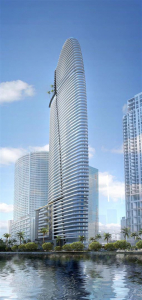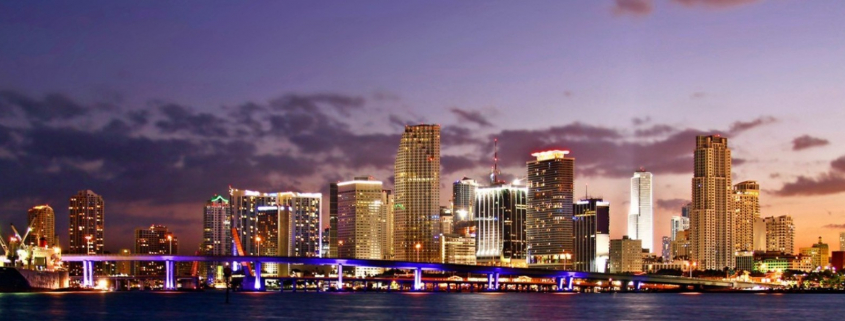Between August 2021 and July 2022, foreigners invested US$6.8 billion in the purchase of properties in Miami Dade, which implies an increase of 34% compared to the previous twelve months.
Posts
Real estate developers, increasingly faced with a bevy of competition, are choosing well-known luxury lifestyle brands to entice buyers with more than just bricks and mortar.
With five luxury brand-affiliated buildings set to open in South Florida by 2021, the sunny region has seemingly become the unofficial home of the branded building, helped in large part by its international buying demographic. The trend is not quite so en vogue in long-established luxury markets. In London and New York City, for example, branding partnerships lean soundly toward hotels as opposed to luxury fashion and automobile brands. But London’s first fashion-brand partnership, a collaboration between Versace Home and the AYKON London One tower in the city’s Nine Elms regeneration zone, is headed to the capital in 2020.
Meanwhile, newer markets like Dubai and Beijing have long been the targets for luxury-branded developments. Dubai’s Armani hotel opened in 2010; last year, Armani’s eco-friendly complex with Smart Hero Group in Beijing was completed. The fashion house is also working on the interiors at Century Spire in Manila, Philippines, set to be completed this year. Meanwhile, Fendi partnered with DAMAC Properties for the interiors of Dubai’s DAMAC Residenze, which opened in 2017.
Miami Likes The Flash
The popularity of the branded-building in the Sunshine State though, boils down to one simple thing, according to one developer.
“Miami is more of a flashier type of city, than other areas like New York or Chicago that are a little more conservative,” said Jon Paul Perez, vice president of Related Group, one of the developers behind Residences by Armani/Casa, set to open in the city in 2019.
The Porsche Design Tower may be one of the most well-known projects to emerge onto the Florida market. The building on Sunny Isles Beach, a barrier island north of Miami, is a collaboration between Dezer Development and high-performance German car manufacturer Porsche.
The 60-story building—designed by Sieger Suarez Architects—was completed last year and comes with a high-powered automobile elevator that transports drivers and their cars from street level to parking at their apartments. Only six of the tower’s 132 residences remain unsold, according to Gil Dezer, president of Dezer Development. Sales launched in 2012.
The automobile collaborations don’t end there. In downtown Miami, British luxury vehicle company Aston Martin has partnered with Argentinian developer G&G Business Developments for their own tower. The 66-story building, set for completion in 2021, will be topped with a triplex penthouse and have amenities like a fitness center and spa, a pool deck and a marina.
But it’s the fashion-conscious buyer that’s really being catered to in the sunshine state. Italian fashion house Fendi paired with developers Château Group for the Fendi Château Residences, the inaugural Fendi-branded residential project. The 12-story building in Surfside was completed in 2016 and houses 58 units, including three penthouses with private rooftop sundecks and swimming pools.
Armani is set to hit the South Florida residential scene in summer 2019 with their Residences by Armani/Casa project. Roughly five blocks away from the Porsche Design Tower in Sunny Isles Beach, the 56-story building is over 75% sold. It’s expected to be finished in the summer of 2019 and the tower will have over 35,000-square-feet of amenities, including a wine cellar and cigar room.
Missoni Baia, in Miami’s Edgewater neighborhood, is a partnership between the fashion house known for its colorful style and developer OKO Group. Designed by Hani Rashid of Asymptote Architecture, the 57-story building is slated for completion in the fall of 2020. It will have 229 residences, ranging in size from 776 to 3,788 square feet.
Why South Florida?
A branded building in South Florida “is a sign of distinction,” said Edgardo Defortuna, the president and CEO of Fortune International Group, the exclusive broker of Missoni Baia.
With so many high-end new buildings from which to choose, being able to distinguish a building is important for developers. And in Miami, where many developers don’t even begin construction until they’ve hit 50% in pre-sales to secure funding and guarantee interest, branding becomes even more important, according to Mr. Defortuna.
“In New York City, you build and then you sell. In Miami, we sell before the building becomes a reality,” Mr. Defortuna said. “To be able to ‘sell the dream,’ so to speak, it’s important to have something to point to.”
Those well-known—and well-respected—brands can theoretically get those buildings built more quickly.
Recipe For Success
Partnership conditions vary from deal to deal, but typically the developer will pay the brand a percentage of sales, typically 2% to 5%, which is paid at the closing of each unit in the building, according to Mr. Defortuna.
“For that fee, the developer has the right to use the name—subject to brand standards—and the brand provides either design or management services, according to the agreement worked out between the parties,” Mr. Defortuna said.
“But for a brand to make a successful foray into real estate, it has to be one that people associate with not only luxury but a certain type of lifestyle that people can relate and aspire to,” Mr. Perez said. “At the same time, it has to be a brand the developer can work with. The brand and designer can have amazing ideas but you have to be able to build those and make them a reality.”
Not only does a partnership have to be chosen with care, but the brand must translate clearly and recognizably into the project.
“In the Aston Martin Residences, it’s not as if the place is emblazoned with wings,” said Marek Reichman, Aston Martin’s chief creative officer and the lead designer on the Aston Martin Residences project, referring to the sports car’s logo. “It’s much more subtle than that.”
Signature materials from the brand’s cars are found in the tower’s interiors, common areas and amenity spaces, like the hand-stitched leather door tabs—sourced from a Scottish village—and the carbon fiber lobby furniture.
“Obviously there’s a design aesthetic,” Mr. Reichman said. “The units remain more neutral. If a customer comes along and is buying, they can make a choice to create their own environment or talk to us and we can advise them or create for them. However much of Aston Martin you want, you can have.”
Not only does the aesthetic matter for the brand itself, but it’s crucial to brand loyalists too, who inevitably become an important section of buyers.
“There’s a real sense of connection with the brand and for our traditionalists that’s brilliant,” Mr. Reichman said. “Buyers so far have been a 50/50 split between customers that know the brand and those who have just come to the showroom regardless of the connection. The real estate venture allows Aston Martin to secure “those new and different customers that we haven’t looked to talk to before because they haven’t come from the traditional automotive channels.”
Who’s Buying?
Foreign buyers purchased $7.1 billion of South Florida residential properties last year, up from $6.2 billion a year ago, according to a recent report by the Miami Association of Realtors. In Miami alone, foreign buyers accounted for 35% of closed sales and purchased 15,400 properties last year, a 41.3% surge from the year before (10,900).
Argentinian buyers led the way, accounting for 15% of South Florida foreign purchases, followed by Venezuela (11%), Canada and Colombia (9% each). It’s for this reason that internationally recognized brands are key.
“Your buyers a lot of the time are from out of the country and associate a lot with these brands,” Mr. Perez said. “They know Armani, even from just going to the stores, they can feel how that is going to transition into the building they’re buying in.”
Of the sales to date at Residences by Armani/Casa, Mr. Perez said 80% have been from international buyers. Robert Thorne, CEO and founder of Miami-based The Wellness Habitat Co., is one of the other 20%. He bought a two-bedroom unit on the 25th floor at Residences by Armani/Casa about two years ago for $1.4 million, as soon as sales launched at the building. The apartment will be Mr. Thorne’s Miami base, he told Mansion Global, now that he primarily lives in Mexico City.
“An important factor in his purchase was the developer,” Mr. Thorne said. “But the brand was the main thing. We had seen the Armani building in Dubai and were convinced by the style. I’m not 100% Armani, but I follow the brand, we have stuff at home from Armani, I wear Armani suits. Just knowing that the brand is behind it, it makes sure that everything else is going to be of quality. We knew our investment was going to be secure.”
Source: Mansion Global
Emilio Palomo (the past chair of the Master Brokers Forum, an elite network of the top real estate professionals in Miami, and the owner/broker of Riteway Properties III) recently went to a party for the opening of a Miami Beach hotel.
He was not familiar with this particular hotel or the people behind it, and attended on the invitation of a colleague. After a few minutes, it became clear to him that most of the guests were from Argentina (or of Argentine descent), and he was not surprised to learn that the owners are themselves native Argentines who have been — somewhat quietly — buying and upgrading Miami Beach hotels for many years.
Emilio worked with buyers and sellers from around the world over the course of his 47-plus years in Miami real estate. He feels fortunate to live in a city that draws so much global interest, with buyers coming from Europe, Asia, Latin America, Canada, and (of course) the U.S. Many find our real estate prices to still be reasonably low compared to their home nations.
Some foreign buyers come here because of political instability and lack of security in their countries, others because of our weather, beaches and everything else Miami has to offer. Whatever the reason, Miami has become one of the most desired international destinations in today’s market for a permanent or second (or third!) home.
And while buyers from Russia, Brazil, Colombia and Venezuela have drawn the biggest headlines for their respective impacts, he believes that Miami’s Argentines have not received nearly enough attention for their significant contribution to the economy and real estate market.
Some of this may be due to the nature of Argentines themselves, who in Emilio‘s opinion and experience tend to be quite modest and discreet. Thanks to referrals from friends in the banking community, over the years he has built a solid base of Argentine clients, and become friendly with many of them. (His Cuban-American family has become close with one particular group for whom he sold and managed units, and recently joined them to make some amazing wine in Mendoza, Argentina.)
But it would seem that the days of Argentines flying under Miami’s “real estate radar” are in the past. Some of the city’s most visible and exciting new projects are being created by developers with deep roots in Argentina, including:
- Mid-Miami Beach’s acclaimed Faena District, a six-block project that features luxury hotels, bars, condominiums, a cultural center and a retail complex, from the visionary mind of Argentine developer/artist Alan Faena.
- The Aston Martin Residences, the car maker’s first branded condominium project, which recently broke ground. The 66-story building located at the mouth of the Miami River is being developed by G&G Business Developments, a Miami-based firm owned by Argentine supermarket magnate German Coto and his mother Gloria.
- The Oceana-branded condominiums in Key Biscayne and Bal Harbour, created by Buenos Aires native (and international art collector) Eduardo Costantini.
In addition to these high-profile projects, observers may have noticed a quiet explosion of Argentine restaurants and other businesses in Miami over the past few years, reflecting the growing population of residents and visitors. From what Emilio has noticed, many of the wealthiest Argentines make their homes in Key Biscayne, but there are also many to be found in Aventura, Miami Beach, Brickell, Downtown, Midtown and Edgewater.
Unfortunately, not all news involving Argentine interest in Miami real estate have been positive.
Last month, The Miami Herald reported that former president Cristina Fernández de Kirchner was accused by the nation’s top anti-corruption official of secretly owning more than 60 Miami properties bought with “dirty money.”
While this item is concerning, Emilio believes that Argentina’s recent change in government, and the stability being demonstrated by its new reform-minded leadership, will put the country on a path toward sustained economic growth. This would obviously allow even more Argentine investment in Miami — the “clean” kind we very much prefer.
Emilio is looking forward to many more years of welcoming Argentines and others who continue to make Miami a dynamic, evolving, and truly international city.
Source: Miami Herald
A federal program that has help fund dozens of big new South Florida business projects over the past decade by swapping U.S. visas and green cards for foreign investment dollars is teetering on the brink of political extinction, according to its supporters.
The EB-5 visa program, which by the estimate of the investment community has funneled more than $18 billion in overseas cash into U.S. business development since 2008 — including hundreds of millions of dollars in Florida — will expire on Sept. 30 unless Congress renews it.
Some of the ongoing high-profile projects that are using EB-5 funds include Florida East Coast Industries’ eagerly awaited Brightline MiamiCentral, the mixed-use downtown Miami station for the upcoming All Aboard Florida passenger rail service. A deal for $130 million in EB-5 funds will go toward the plaza’s 180,000 square feet of retail space.
SkyRise Miami, the ambitious 1,000-foot skyscraper/tourist attraction planned by developer Jeff Berkowitz to launch in 2020, would also include EB-5 funds as part of its $430 million budget.
But the EB-5 faces congressional critics who want to amend the program into oblivion or even it kill it outright. And even to get a fair hearing, it must compete for attention with the always-contentious federal budget, President Trump’s tax-reform proposal and a score of other high-priority items with upcoming deadlines.
“I think Sept. 30 is the drop-dead for renewal,” said Miami immigration attorney Tammy Fox-Issicoff, who frequently works with EB-5 investors. “And I mean that’s the drop-dead date for a full renewal. We’ve had a number of short extensions. That’s killing the program’s credibility with foreign investors who might like to join. Nobody wants to put half a million bucks into something that might be gone in three months.”
What is EB-5?
EB-5 visas were first created in 1990 as part of a larger congressional reform of immigration policy. They allow a foreigner who invests $1 million in a project that will generate at least 10 long-term jobs to get a visa and a green card if the project is completed. The required investment drops to $500,000 if it’s directed at a high-unemployment area.
But EB-5s didn’t really take off until 2009, when the Great Recession dried up commercial lending around the United States. As banks and other traditional credit sources retrenched, businesses started using EB-5 investment to patch the holes they left.
“As a result of those absences, you had to look for alternative sources of financing,” said Michael Conaghan, chief operating officer at Fort Partners, the developer of the Four Seasons Hotel and Private Residences at the Surf Club in Surfside. Conaghan is raising up to $200 million in EB-5 money to build a Four Seasons hotel-residence in Fort Lauderdale. “Since then, EB-5 has proven to be a good source of financing for projects. It also brings new people and new capital and new jobs to the country. A lot of other visa programs focus on people who are already here.”
EB-5 critics say it’s an inefficient investment tool, a needless subsidy to wealthy developers, and an easy target for manipulation and corruption.
“What it mostly does is it saves money for a lot of folks who are already rich and are just getting richer,” said David North, a senior fellow at the Center for Immigration Studies, a Washington think-tank that’s harshly critical of immigration.
But what nobody disputes is that from beer joints to giant train lines, EB-5 funds are fueling economic development and local businesses in South Florida at an increasing rate. According to the latest figures available from the industry trade organization Invest in the USA, EB-5 investment throughout the state shot up from $10,500,000 in 2011 to $150,500,000 in the fiscal year 2013.
The precise impact of the EB-5 is nearly impossible to measure because the government keeps few statistics on the program. No one knows exactly how many EB-5 projects have succeeded, how many failed, or how many jobs have been created.
But the money definitely ripples through other economic measures. Invest in the USA estimates that the total gross domestic product contributed to Florida by EB-5 projects grew from $15 million to $179 million. State and local tax revenue went from $858,822 to $10,918,299.
Mezzanine Funding
Usually, EB-5 money serves as what developers call “mezzanine funding,” which fills the gap between what banks will finance and a project’s total cost.
“In a typical project, the developer is going to have some of his own money involved, maybe 20 to 25 percent of the total cost,” said Ron Klasko, a Philadelphia lawyer who has worked on 10 EB-5 projects in South Florida and hundreds across the country. Another 40 percent or so will come from a construction loan — what’s called the senior loan. And the other 35 percent is the mezzanine loan.”
Mezzanine loans obtained from a bank or other traditional lender might charge 14 to 18 percent. But because EB-5 investors are interested in getting their green cards, they are willing to accept a tiny fraction of that, often between 1 and 3 percent interest.
Funding for these projects is usually put together by federally designated business enterprises known as EB-5 centers that act as conduits for the program’s investment money. As recently as 2010, there were less than 100 EB-5 centers around the United States; now there are more than 850. Although they finance everything from farms to body shops, most of their money goes into real estate projects. In Florida, that has included everything from small businesses to mammoth developments.
Doug Rudolph, the CEO of Tapco Restaurant Group, says its first two Tap 42 Craft Beer Bar & Kitchen restaurants — the Boca Raton location, which opened in 2015, and the Coral Gables spot, which opened in 2016 — each used $2.25 million in EB-5 money, or 80 percent of their total construction costs.
The group’s other two locations — one in Midtown, which opened in June, and an upcoming spot at the Aventura Mall expansion — used $2.5 million each. Rudolph said the three existing restaurants have created “three to four times” the number of jobs required under EB-5 rules. That number varies depending on the size of the investment.
“People who want to invest in businesses that are creating jobs can touch and feel and meet us,” Rudolph said. “They can come into one of our restaurants and eat there, so they know exactly what they’re investing in. Most EB-5 investors intend to live in the same city as their investment, and they like the idea of being part of a local business. They feel closer to their communities.”
The $200 million mixed-use Hollywood Circle development, currently under construction on a 3.2 acre lot on U.S. 1 and Hollywood Blvd., will be composed of a trio of residential towers that will include a boutique hotel, gourmet restaurant, parking garage and a Publix supermarket. The budget includes $109 million in EB-5 funds.
The project is being developed by the Gold Coast Florida Regional Center, which was created in 2010 as a way to fill the void left by the departure of Lehman Brothers, Morgan Stanley and other big financial players from the real estate scene after the 2008 recession.
“We buy money just like plywood for development,” said Charles Abele, a founding partner of Gold Coast. “It’s one of the commodities needed to do what we do, so we decided to raise our own equity. EB-5 serves as a sweetener for every deal.”
Unexpected Benefit
Developers of the 60-story Paramount condo tower at the Miami Worldcenter mixed-use project under construction in downtown Miami say that EB-5 visas have been not a key element in their financing more than $50 million of it — but they say they have become an unexpected marketing tool for the project.
“Four of the 10 units we sold in June went to someone who came to the sales center intending to buy an EB-5 and bought a condo instead,” said Peggy Fucci, president and CEO of the real estate firm OneWorld Properties, the exclusive broker on the Paramount tower. Potential EB-5 investors have pockets deep enough to buy a condo at the tower, where prices start at $700,000.
Curiously, despite the tumultuous state of the U.S. debate over immigration, very little of the criticism of the EB-5 concerns the visas themselves or the 10,000 foreign investors and their family members (the annual cap on EB-5 immigration set by law) who use them to get into the United States each year.
“Most people don’t realize that a million immigrants come into the country each year,” said North, a strong critic of the EB-5. “In the context of a number like that, 10,000 is nothing, a drop in the bucket.”
A much bigger sticking point is what nearly everybody, including the most enthusiastic backers of the EB-5, admits is the program’s inefficient administration by a lumbering immigration bureaucracy that knows lots about visas but very little about cash flow, capitalization or anything else that goes into real estate development.
“The immigration component of the EB-5 program is trivial,” said Philadelphia attorney Klasko. “The EB-5 program doesn’t belong with the immigration service. Immigration officials don’t normally deal with reviewing securities offerings or economic reports or business plans. It creates problems at several levels. When you’re talking about the pace of business — especially in real estate development — it just doesn’t make any sense for immigration officials to say, ‘File your plan with us today and we’ll review it in a year and half.’ That’s not very realistic. But that’s the reality.”
An Uneasy Mix
The EB-5s uneasy mix of politics, business and immigration can lead to practices that are dubious in all three areas. One of the things most frequently denounced is what EB-5 players call “gerrymandering,” after the legislative practice of creating grotesque-looking districts to give one party or another an election advantage.
In the EB-5 version of gerrymandering, developers use tortuous geographic logic to link luxury developments in upscale metropolitan areas with blighted, poverty-stricken districts miles away. That allows them to get access to EB-5 money that’s intended for high-unemployment areas. Because the high-unemployment EB-5 investments can be smaller ($500,000 instead of $1 million), they are more plentiful.
The linkage is possible because the EB-5 law permits the developers to create so-called targeted employment areas, without regard to how large or misshapen they are, as long as the territory consists of adjacent U.S. Census tracts (small areas that are home from 1,200 to 8,000 people).
“We need more regulation on this,” said Rodrigo Azpurua, head of the Riviera Point Development Group, a Broward firm that has raised more than $53 million in EB-5 funds since 2012 to partially fund projects such as the Riviera Point Business Center Doral and the Radisson Red Miami Airport. “Right now, you can pretty easily build a line of Census tracts from Liberty City, where the unemployment rate is 20 percent or so, to Brickell, where it’s zero, and use the Liberty City unemployment to justify a luxury hotel in Brickell.”
Azpurua’s Brickell-to-Liberty City example is, if anything, understated. A 2015 lawsuit in Texas brought to light a targeted employment area that stretched through 190 Census tracts and five counties to link the battered, unemployment-plagued city of Brownsville with a planned upscale hotel in the city of Laredo, 200 miles away.
Not everyone agrees that the Where’s-Waldo? games with Census tracts are a problem. Immigration attorney Fox-Isicoff argues that the location of a project has little connection with where it will create jobs.
“I work on Brickell, but I live in North Miami,” Fox-Isicoff said. “I must drive through 12 or 15 or 20 Census tracts on my way to work each day. Same thing for most of the people in my office.”
And geography becomes even more irrelevant, she says, when the subject is so-called induced jobs — say, the people working in distant factories who manufacture the brick and steel and window glass that go into the construction projects.
“Those are all allowed to count toward the 10 jobs that must be generated by an EB-5 investment,” Fox-Isicoff said. “Does that mean every EB-5 project has to be built next door to a brick factory?”
The Gerrymandering Situation
Others, however, believe that EB-5 gerrymandering is part of a larger problem — that the allure of a potential visa makes investors look past red flags that something is awry. In recent years, EB-5 investors have been victimized in staggering corruption cases in Vermont and South Dakota in which the middlemen packaging their loans ran off well over $100 million of their funds or lost it in unauthorized investments.
The investors not only lost their money (a total of well over $100 million) but their visas, which aren’t awarded unless an investment program is successfully completed.
“It’s true that you can have a Bernie Madoff situation in any investment, with crooks taking your money,” said North. “But the likelihood in an EB-5 investment is greater because the intent of the investment is greater. A bank making a loan is looking for a good investment with solid security. EB-5 investors would like to have their money back eventually, but what they really want is the visas. And they don’t pay much attention to anything else.”
Fox-Isicoff agreed: “Inherent in the EB-5 program is the element of risk. The element of, ‘This may not work. You may not be paid back.’ People lose sight of that fact.”
The bureaucratic delays in the EB-5 program only make matters worse.
“Developers can’t wait two years before they start getting their money from investors, so a lot of times people are making their investment before the government has even reviewed the project,” noted Klasko.
The clumsiness of the EB-5 as an economic tool has led some to suggest that it be replaced with a program that simply sells a certain number of U.S. green cards, just as some two dozen other countries around the world offer citizenship for cash.
The government could use the receipts to create jobs programs wherever they were needed, not just in the high-profile urban areas that developers favor. (A pair of 2016 studies by New York University scholars of the 52 largest EB-5 projects in America since 2009 showed that nearly 40 percent of their money went to a single borough of New York City: Manhattan.)
“If we’re going to prostitute our visa process, let’s get a lot more money for it,” said North. “I’d run an auction. Charge whatever the market would bear. Let the government keep the money instead of giving it to big developers.”
EB-5 Opponents
That’s not one of the proposals on the table in Congress. Those range from killing the EB-5 visa outright to drastically raising its price — which might kill it anyway, many EB-5 supporters say. And although President Trump’s aversion to immigration is well known, the proposals to curtail the EB-5 originated well before his election.
Before President Obama left office, the Department of Homeland Security, which oversees the EB-5 program through its United States Citizenship and Immigration Services office, proposed a series of changes that would raise the minimum EB-5 investment from $500,000 to $1.35 million.
“If the cost goes above $1 million, that’s going to seriously impact the program,” said attorney Randy Sidlosca, a partner in the EB-5 Immigration Investor Program Practice at Cozen O’Connor in Miami. “People just don’t want to part with a million dollars for five or six years, which is how long it usually takes to get your money back from an EB-5.” Sidlosca favors a compromise increase to $850,000, which is gaining support in the EB-5 community. “We can live with that,” he said. “Change is going to come, it’s inevitable, and we need to accept that.”
Compromise is possible, said Ronald Fieldstone, one of the most active EB-5 attorneys in Miami, because the fight about EB-5s is about money rather than ideology, a subject Congress knows how to negotiate.
“This isn’t about Trump and people who don’t like Trump, or Republicans and Democrats, or pro-immigration and anti-immigration,” Fieldstone said. “It’s about rural versus urban. The most combative opponents of EB-5 are people like Iowa’s Republican U.S. Senator Charles Grassley, whose state gets almost none of the EB-5 money because of the way the program has been administered. … I think this can get worked out.”
Source: Miami Herald
The Argentine investor who made international headlines in 2014 when he paid $125 million for 1.25 acres along the Miami River has filed plans to build a 69-story condo tower there.
Riverwalk East Developments, led by German Coto and Gloria Coto from a family that owns a supermarket chain in Argentina, wants to build the project at 300 Biscayne Boulevard Way. Tentatively named Epic 2, it would have 384 condos in 1.09 million square feet and 561 parking spaces. When combining the condos with the parking and other amenities, the tower would total 1.64 million square feet.
The sail-shaped tower would be topped with a lighthouse feature. It would have an open-air pool deck on the 55th floor, plus a gym and sky lobby.
The Miami River Commission’s Urban Infill Committee recently approved the Epic 2 project with conditions, namely that its new public riverwalk be widened to 15 feet from 12 feet. The riverwalk would allow people to walk from Bayfront Park to Brickell along the mouth of the Miami River.
“This is probably the most desirable location for the public to enjoy the river and the bay at the same time,” MRC Chairman Horacio Stuart Aguirre said. “That river walk will be one of the most desired locations for early morning and later afternoon strolls to take in the fresh air and enjoy the view.”
Aguirre said the building’s design is architecturally appealing, although it would need extra-strong structural support to handle hurricane winds because it appears narrow. He expects the project to receive the recommendation of the full MRC board in about three weeks. The project would also require city approval for its design. The density falls within the property’s current zoning.
The bigger question is whether the Miami condo market can handle another project where unit prices are expected to average more than $1.5 million. Sales to the foreign buyers that fuel the market have slowed down in recent months, and several experienced developers have decided not to launch sales for new projects until the market picks up. On the Miami River, Kar Properties’ One River Point and a project by the Chetrit Group are already competing for high-end buyers. However, the Epic 2 site is further east along Biscayne Bay, while those two are upriver.
Source: SFBJ
According to the Miami Association of Realtors, the Miami real estate market continued to perform robustly in the fourth quarter of 2014 due to increasing demand from both domestic and international buyers.
Median and Average Sales Prices Continue to Rise
The median sales price for single-family homes in Miami-Dade County increased to $246,140 in the fourth quarter, a 4.7 percent jump compared to the same period last year. The median sale price for condominiums increased 8.6 percent to $190,000 in the fourth quarter compared to a year earlier. Miami-Dade County has now seen 12 consecutive quarters of growth for both single-family homes and condominiums.
“We expect Miami home prices to continue to increase in 2015 but at a more moderate rate,” said Christopher Zoller, a 27-year Miami-based realtor and the 2015 Residential President of the Miami Association of Realtors. “Limited supply and strong demand for single-family homes is still reflective of a seller’s market. There is also strong demand for both new construction and existing condominiums, so we will continue to see price growth for residential properties in Miami-Dade.”
Nationally, the median sales price of existing single-family homes was $208,700 in the fourth quarter, up 6.0 percent from the fourth quarter of 2013, according to the National Association of Realtors. The national median sales price for condominiums was $203,300, a 3.3 percent increase over the previous year.
The statewide median sales price for single-family existing homes in the fourth quarter was $180,000, up 5.9 percent from the same quarter a year ago, according to the latest housing data released by Florida Realtors. The median sales price for condominiums in Florida was up 7.9 percent compared to the same quarter last year at $143,000.
Compared to the fourth quarter of 2013, the average sales prices for condominiums in Miami-Dade County increased 18.5 percent to $375,269. The average sales price for single-family homes decreased 2 percent to $394,095.
Sales Continue to Rise for Single-Family Homes
Sales of single-family homes, which set an all-time record for all of 2014, increased 7.7 percent to 3,426, while condominiums decreased 3.3 percent to 3,981 compared with the same period in 2013.
There were 7,407 homes and condos sold in Miami-Dade County during the fourth quarter of 2014, an increase of 1.5 percent compared to the fourth quarter of 2013.
“Much of the increase in single-family home sales activity is due to consumer confidence,” said Carlos Gutierrez, the principal Realtor of Gutierrez Group Miami Real Estate and the 2015 president-elect of Miami Association of Realtors. “Many buyers who were staying on the sidelines are now buying. Huge gains in job growth and more solid economic indicators are resulting in more consumers returning to the housing market.”
Nationally, total existing-home sales, including single family and condo, declined 1.0 percent to a seasonally adjusted annual rate of 5.07 million in the fourth quarter from 5.12 million in the third quarter, but are 2.6 percent higher than the 4.94 million pace during the fourth quarter 2013.
Statewide closed sales of existing single-family homes totaled 62,080 in the fourth quarter 2014, up 14.9 percent over the fourth quarter 2013 figure. Statewide closed sales totaled 26,070 during the fourth quarter 2014, up 4.8 percent compared to the same period last year.
Residential Inventory Moving Rapidly Despite More New Listings
Home and condominium listings also increased in the fourth quarter of 2014. There were 5,716 new single-family home listings during the fourth quarter, a growth of 3 percent relative to the same period last year. New condominium listings increased by 4.2 percent from 7,585 in the fourth quarter of 2013 to 7,907 in the fourth quarter of 2014.
Fourth quarter active listings in Miami-Dade County totaled 17,695, representing an increase of 10.8 percent.
At the current sales pace, the number of active listings represents 5.6 months of inventory for single-family homes and 8.4 for condominiums. Compared to the fourth quarter of 2013, the months’ supply of inventory for condominiums increased 19.7 percent. The inventory for single-family homes decreased 0.2 percent compared to the same period from last year. A balanced market between buyers and sellers offers between six and nine months of supply inventory.
The median days on the market of single-family home listings during the fourth quarter was 45 days compared to 40 days during the same period last year, an increase of 12.5 percent. Similarly, the median days on the market for condominium listings were 58 days compared to 47 last year, an increase of 23.4 percent.
Percentage of Cash Sales Declines
In the fourth quarter of 2014, 55 percent of closed sales were all cash compared to 60 percent a year ago. All cash sales were 41.4 percent of single-family home closings and 66.9 percent of all condominium sales. Since nearly 90 percent of foreign buyers pay cash, this reflects Miami’s top position as a prime market for foreign buyers. Miami has a significant percentage of international buyers, generating more than double the cash transactions than the national average.
December 2014 New Construction Market Update
Strong sales in the coastal new construction condominium Miami market (east of I-95) continue to reflect significant demand for new properties, according to the latest New Construction Market Status Report released today by Cranespotters.com and the Miami Association of Realtors.
As of December 29, there were nine (9) towers with 981 units that had been completed through 2014 in Miami-Dade County east of I-95, 66 towers with 9,598 units under construction, and 73 towers with 10,554 units that are planned but have not begun development. There are also 54 towers with 7,905 units that have been announced but not approved.
Overall in Miami-Dade County, developers had announced 202 towers with 29,038 units since 2011 through December 29.
Source: World Property Journal
Just how hot is Downtown Miami’s condo market?
New stats are rolling in that make investors smile and developers move perhaps even more quickly. For starters, Downtown Miami’s condo market has posted two straight years of price appreciation. At the same time, land values are escalating and developer yields are compressing. Overall, land transaction volume is increasing. All this is according to a new study the Miami Downtown Development Authority (DDA) commissioned.
“The demand drivers of an urban lifestyle continue to provide motivation for suburban or Miami Beach residents to reconsider the Downtown Miami area,” says Anthony M. Graziano, senior managing director for Integra Realty Resources in Miami. “As the large-scale projects continue to progress, along with the development of a more transit-oriented metro area, Downtown Miami will benefit from increased downtown housing options.”
Turning to rentals in the urban core, prices are rising. That, in turn, is supporting more end-unit pricing increases and an overarching demand for new multifamily projects. Specifically, rents in Downtown Miami are appreciating by over 5% each year and are on track to experience annualized increases of 8% in 2014.
With such strong demand, new rental construction is moving ahead at a rapid clip. Developers currently building 2,301 multifamily units in five downtown projects. Another 2,742 units are in the planning phase of development to meet the demand, including strong demand from Millenials, who are moving to Downtown Miami in droves.
The third quarter saw some of the biggest blockbuster land sales in history, including the Epic Marina Site in the CBD that sold for $125 million, representing $2,296 per square foot. Ten land sites have either recently sold or are being marketed for sale through July 2014. In addition, there are three additional land transactions all upward of $50 million expected to close by the fourth quarter 2014.
“In 2008 many condos were sitting empty and pundits predicted they would remain dark for years to come,” says Alyce Robertson, executive director of the Miami DDA. “Local job growth, combined with foreign buyers and investors from Europe, South America and Asia have acquired most of the inventory and prices are again increasing even as dozens of new projects are in the works. Downtown Miami is witnessing a metamorphosis and evolving into a true 24/7 city as restaurants and retailers come online in the urban core.”
Source: GlobeSt.
About Us
Ven-American Real Estate, Inc. established in 1991, is a full service commercial and residential real estate firm offering brokerage and property management services.
Subscribe
Contact Us
Ven-American Real Estate, Inc.
2401 SW 145th Avenue, Ste 407
Miramar, FL 33027
Brokerage & Property Management Services
Phone: 305-858-1188


